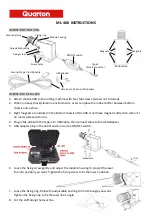
ULTRAFLOW® 54 DN15-125
Kamstrup A/S · Technical description · 5512-2464_D1_GB_09.2021
71
7.9
Test mode
To minimize the time spent on calibration, ULTRAFLOW® 54 can be switched into test mode. When ULTRAFLOW® is in
test mode, the measuring routines only take one fourth of the time they take in normal mode.
ULTRAFLOW® is put into test mode by connecting pin 4 (Verification/Adjustment) on the internal connector to ground
(GND), which is located at pin 1 or 2, respectively (see
) and subsequently connecting the supply. After approx.
1 second, the sensor goes into test mode and the connection between pin 4 and frame must be disconnected again.
Test mode is ended automatically by disconnecting the supply to the sensor.
<
ULTRAFLOW® in test mode uses approx. 3 times as much power as in normal mode. However, this does not influence
the total battery lifetime of the energy meter as the total duration of ULTRAFLOW® in test mode is negligible compared
to the operating time of ULTRAFLOW® outside test mode.
7.10
Externally controlled start/stop
In connection with calibration by means of serial data, e.g. in connection with NOWA, ULTRAFLOW
®
54 can be monitored
by an external signal when it is in verification mode (see paragraph
). This is done by grounding pin 4 of the
internal plug when starting the test and removing it when the test has been completed. The volume of water that has
been accumulated during the test can be read serially.
The accumulation is based on the same data as those used for calculating the number of pulses to be emitted.
In addition to accumulating water volume during test, the sensor corrects for the excess quantity in connection with start
as well as the quantity lacking in connection with stop. These deviations are due to the fact that the sensor measures
flow and calculates volume at fixed intervals as illustrated in
Figure 56
The excess quantity of water in connection with start is the water volume that passes through the sensor
𝑡
𝑏1
before the
first accumulation
𝑉
1
within the test period. In the same way, the lacking quantity is the water volume passing through
the sensor
𝑡
𝑒1
after the last accumulation
𝑉
𝑛
until stop.
The volume accumulated during the test can be stated as:
𝑉
𝑡𝑒𝑠𝑡
=
𝑡
𝑏2
𝑡
𝑏1
+ 𝑡
𝑏2
∙ 𝑉
1
+ 𝑉
2
+ ⋯ + 𝑉
𝑛
+
𝑡
𝑒1
𝑡
𝑒1
+ 𝑡
𝑒2
∙ 𝑉
𝑛
















































